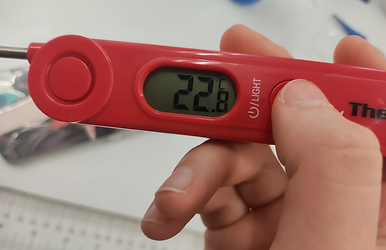
Materials and Methods
This experiment demonstrates an acid-base reaction between citric acid (C₆H₈O₇) and sodium bicarbonate (NaHCO₃) to produce carbon dioxide (CO₂) for beverage carbonation. Stoichiometric calculations determined reactant quantities (0.35 g citric acid, 0.46 g baking soda), while controlled conditions (sealed container, refrigeration at 4–6°C) optimized CO₂ dissolution. The percent yield (85.6%) quantified reaction efficiency, illustrating principles of gas solubility and neutralization chemistry.




1
Materials
Equipment & Tools:
-
Digital balance (±0.01 g precision)
-
25 mL graduated cylinder (for precise water measurement)
-
100 mL narrow-neck plastic bottle (to minimize headspace)
-
Micro spatula (for transferring small solid quantities)
-
Stirring rod (thin, 15 cm long)
-
Thermometer (digital, ±0.1°C accuracy)
-
Refrigerator (calibrated to 4±1°C)
-
Timer (with 1-sec resolution)
2
Chemicals (Reduced Quantities)
-
Citric acid (0.35 g ± 0.01 g)
-
Sodium bicarbonate (0.46 g ± 0.01 g)
-
Sucrose (5.00 g ± 0.05 g)
-
Purified water (25.0 mL ± 0.5 mL)
-
Food-grade flavoring (0.5 mL, if used)
3
Procedures
1. Balloon Preparation:
-
Using dry funnel, pour 0.46g baking soda into balloon
-
Stretch balloon neck over beaker mouth (don't let powder fall in yet)
-
Ensure airtight seal between balloon and beaker rim
2. Solution Preparation:
-
In separate container:
-
Dissolve citric acid/sugar mix in 25mL water
-
Stir until completely clear (~20 sec)
-
Pour solution into prepared beaker
3. Reaction Initiation:
-
Lift balloon upright, allowing baking soda to descend into solution
-
Immediately pinch balloon neck shut
-
Gently swirl beaker 3 times (1 rotation/sec)
-
Observe CO₂ production (balloon inflation)
5. Data Collection:
-
Start timer and scale when baking soda contacts solution
-
Measure the mass of balloon and beaker(with the solution)
-
Calculate CO₂ volume from balloon mass and amount of CO₂ loss/produced, also the mass of the solution before and after the reaction




Get in Touch
If you have any suggestion of adding other metrials contact us.
Or follow me in instagram:zmlevick